2022 was one of Kansas City’s deadliest years. Leaders tout new plan, but will it work?
When Shayla Curts, a 22-year-old mother who was eight months pregnant, was shot and killed just weeks before Christmas in Kansas City, her mother was left to raise her two young children.
Curts’ mother, who has a child at home already, was suddenly confronted with her own grief and that of her grandchildren. Shayla Curts’ unborn child also did not survive the shooting.
So when Melesa Johnson, the deputy chief of staff for Mayor Quinton Lucas’ office, called Curts’ mother, Johnson recognized a few ways the city could support the mourning family.
Through a new program called Partners for Peace, Johnson is in the process of helping set Curts’ mother up with a larger apartment and counseling for her and her grandchildren. She’s one of dozens of people the program has assisted since launching in late summer.
Partners for Peace is a collaboration between the city, the Jackson County Prosecutor’s Office and the Kansas City Police Department. It brings together local agencies and nonprofits to administer resources and assistance to families after a loved one is wounded or killed in a shooting.
The program’s ultimate goal — to reduce future violence through intervention methods — begins with contacting every victim of a non-fatal shooting and family of a homicide victim and asking what they need.
There’s no shortage of people to help.
In 2022, despite murders being down in some other large cities 5% nationwide from last year, Kansas City suffered its second-deadliest year in recorded history with 171 killings, which includes three fatal police shootings, becoming the third year in a row with staggering violence in the city. In 2020, the most homicides ever were recorded, with 182 lives lost. The next year was the third-deadliest year, with 157 killings in 2021.
One year ago, as 2021 came to a close, experts said a comprehensive and collaborative approach that is well-funded and involves different stakeholders remained elusive in Kansas City.
After years without a clear, collaborative anti-violence plan, local officials are pointing to Partners for Peace as a solution: a new iteration of the Kansas City No Violence Alliance, the last program that many local leaders pointed to as actually working to reduce violence.
But alone, is it enough to break the city’s grim trend?
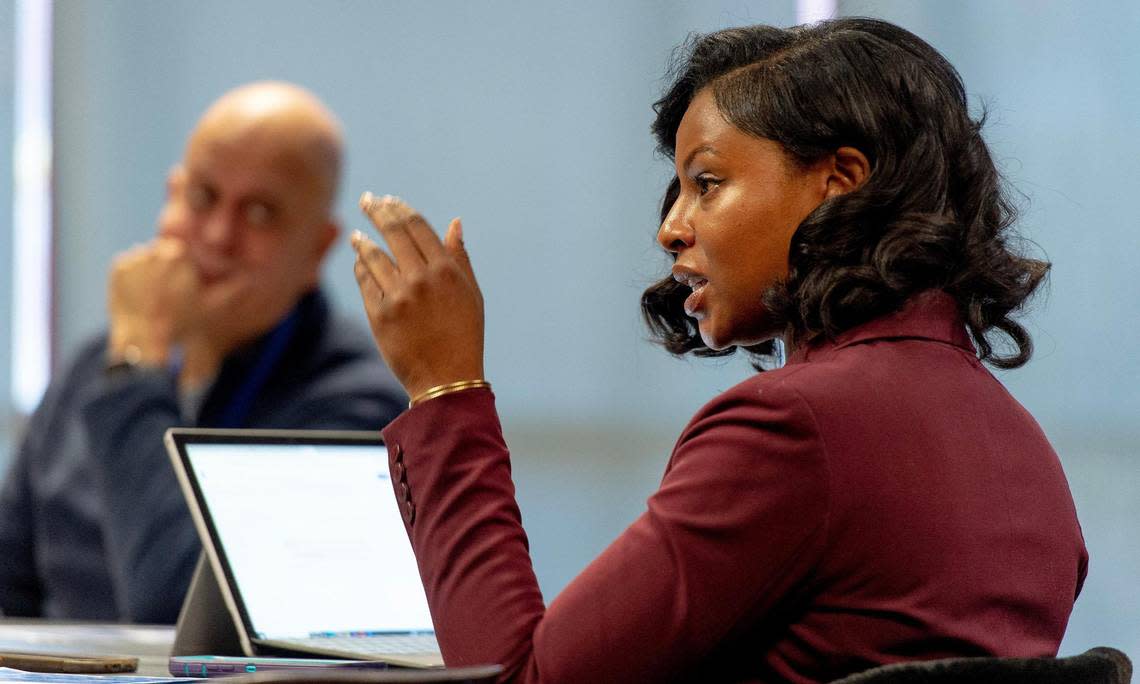
The second-deadliest year on record
Across the entire metro last year, at least 264 were killed, according to data tracked by The Star. Of the 171 homicides Kansas City suffered, more than 90% of the victims were shot, according to police data. Eighteen of the victims were 18 or younger. By New Year’s Eve, 542 people had been shot and lived.
Among those killed in Kansas City were DeVohn Dudley-Reese, a 16-year-old high school quarterback with dreams of playing college football at a historic Black college or university; Sterling Simpson, a 26-year-old father who started fixing up bicycles to ride together as a family when his two girls got older; and Era’Shae Johnson, 23, a recent graduate of Pittsburg State University who was eager to begin a new job working with kids with special needs.
The list of victim names goes on and on.
“I see it as an incredible failure of this city and all of us connected to it,” Lucas, the mayor, told The Star in the final weeks of 2022. “I take it intensely personally.”
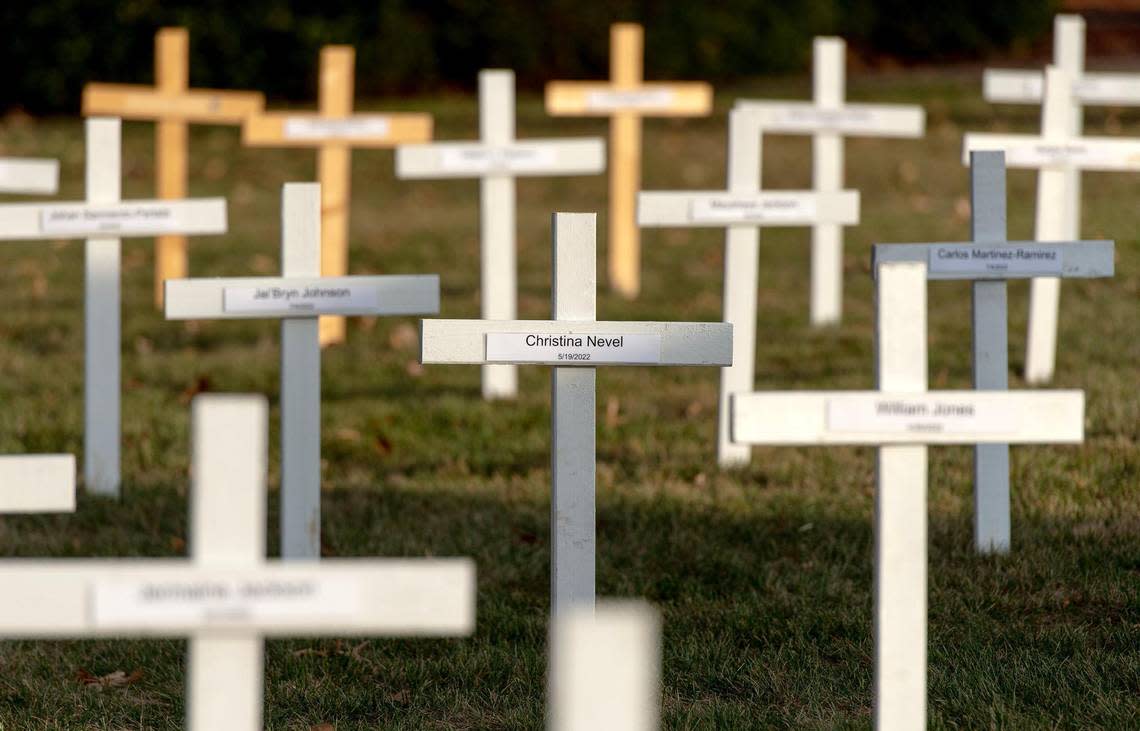
Recently, a woman approached him asking about solutions to gun violence. Lucas lamented how lax gun laws are in Missouri, complicating efforts to reduce gun violence. The state has some of the least restrictive gun laws in the country, and because it’s a constitutional carry state, a permit isn’t needed to carry a gun. State legislators in 2016 voted to allow convicted domestic abusers to carry firearms. And the second amendment preservation act prevents state and local law enforcement from enforcing certain federal gun rules.
His response didn’t sit well with the woman.
“No, no, no, no,” she said. “But you the mayor. If you can’t do nothing, then what the hell am I going to do?’”
Partners for Peace
An effort launched nearly a decade ago by former KCPD Chief Darryl Forté, former Mayor Sly James and Prosecutor Jean Peters Baker, called the Kansas City No Violence Alliance, or KC NoVA, garnered national attention after killings dropped to a historic low of 86 in 2014, the fewest in Kansas City in more than four decades.
Under KC NoVA, law enforcement agencies used “focused deterrence” — targeting violent people and their associates and offering them a choice: change your behavior or go to jail. In exchange, they received help finding jobs, getting an education and other assistance.
When Forté retired and former KCPD Chief Rick Smith took over, he killed the program, leaving the city without a meaningful violence reduction plan, critics have said.
Other anti-violence programs have been introduced since, but none have flourished.
In 2018, when the city joined the U.S. Department of Justice’s National Public Safety Partnership, the DOJ sent a professional team to KC to create a strategic plan focused on reducing violent crime. In its final report it concluded Kansas City needed to focus on four areas: enforcement, prevention, intervention and trust-building.
While the police department, in charge of enforcement, added shoot reviews — a collaborative review of recent shootings — as recommended by the DOJ, local leaders said a strategic and collective plan around prevention and intervention was still lacking.
The DOJ recommendations didn’t come with funding. Nor did the agency task any particular person with executing the plan. Instead, the city tried to create a number of programs in response to the DOJ report, including the Community Safety Partnership and KC360, which differs from the KC 360 pilot program focused on violence prevention currently rolling out through the non-profit KC Common Good. But none of the city efforts were able to get off the ground in a meaningful way.
“This isn’t a secret: in very recent Kansas City history, when there was a different chief in office, there was an infrastructure where none of us were really talking to each other, none of us were getting along,” said Johnson, the mayor’s deputy chief of staff, who took over the city’s violence reduction and public safety initiatives in February 2021.
Last spring, around the same time interim chief Joseph Mabin replaced Smith as head of KCPD, members of the police department, prosecutor’s office, city and local anti-violence advocates were shut in a room together as part of a Harvard-Bloomberg-funded innovation program and told to create a plan to address violent crime.
Johnson, who was part of the team, said while the conversations were difficult, they were also re-energizing. They immediately started developing a new program.
“We said, ‘Listen, we’re going to build this plane while we fly it, but there’s no more NoVA, there’s no more city-wide collective. We have to stand in that gap,’” Johnson said.
By August, Partners for Peace came to life despite little fanfare.
But internally, the collaboration was highly celebrated. After years of recent clashes that played out publicly between the former police chief, the mayor and the prosecutor, members of all three camps were finally all in one room, working toward a shared goal.
Intervention work
The first day Partners for Peace met in August, Aim4Peace, another anti-violence program under the umbrella of Partners for Peace, referred a family of 18 to them. The family wanted to cooperate with law enforcement as they investigated a crime, but feared for their lives due to the threat of retaliation. Partners for Peace successfully relocated the whole family out of the city and helped them find new jobs.
A few months later, Johnson knocked on the door of a man killed in a homicide and was greeted by his four children, including a 16-year-old boy. She connected with the boy’s mom who said he’d been struggling in school since the death of his father. Partners for Peace helped him get therapy, and his mother said it’s helped.
Around the same time, two teenage girls were caught in a crossfire while driving across the city.
Partners for Peace immediately got them assistance with the help of a child protection agency that provided therapy and made sure they had Christmas gifts under their trees.
Prior to Partners for Peace, only victims whose cases had led to charges were given these resources through a victim advocate provided by the prosecutor’s office. For those whose cases remained unsolved, no consistent help was available.
In a city where only 77 of last year’s homicides were cleared — meaning a suspect was identified and charged, unless prosecutors decided not to pursue charges — that created a huge gap in who received help.
Partners for Peace has stepped into that space, making resources available for families regardless of whether a crime is solved, and trying to address some of the social issues that can lead to violence.
The root causes of gun violence are linked to inadequate housing and food insecurity, as well as an increased availability of guns, systemic inequality, a lack of trust in police and domestic violence, among other concerns, according to researchers.
A public health approach to gun violence means investing in improving conditions that put people at greater risk: income, housing and food security, schools and living environments — researchers call these the social determinants of health.
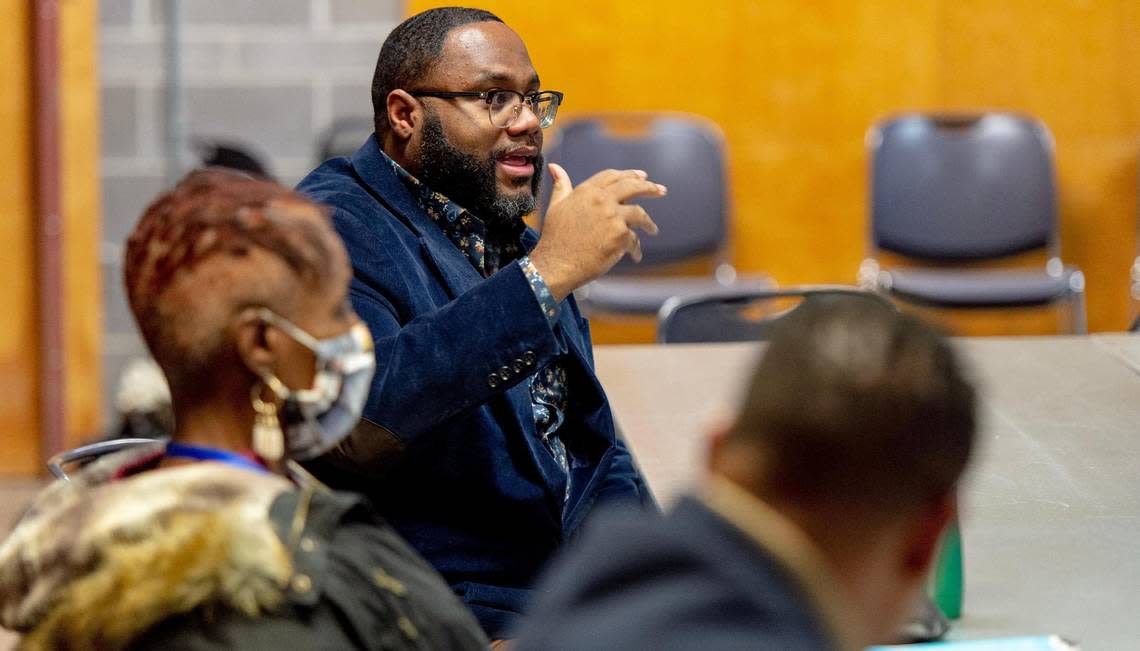
“What does it look like if we intervene on a homicide victim’s brother who might be thinking about creating justice and avenging his brother by himself?” Johnson said. “And what does it look like if we get him a job? If we get him trauma-informed counseling? If we get him access to rent and utility assistance so that he can actually grieve. That creates room for a person to actually have the space to grieve instead of being in survival mode. We want people to thrive, even those that have been involved in very tragic and unfortunate circumstances.”
Since August, Partners for Peace has connected services to more than 120 people affected by violence in Kansas City.
On the Wednesday before Christmas, Partners for Peace met at the Gregg Klice Community Center in the city’s 18th & Vine neighborhood. Representatives from the mayor’s office, prosecutor’s office, police department gathered in one room with pastors and organizations like Corey’s Network, Ad Hoc Group Against Crime and Rose Brooks, a domestic violence shelter.
One woman Johnson met earlier that month had been beside her boyfriend when a vehicle drove up to their car and opened fire on them. She drove him to the hospital where he died. Now she’s looking for grief counseling, Johnson told the group. She’s also scared for her own life, and hasn’t returned home since the shooting. The group discussed who among them could provide counseling, and who could help her relocate.
While surviving loved ones of homicide victims are the focus of Wednesday meetings, every non-fatal shooting victim is guaranteed outreach through a new data tracking management system.
As soon as a non-fatal shooting victim is input into the system, they are automatically assigned to Partners for Peace service providers.
Expanding beyond victims
But for now, their resources remain limited.
Johnson is currently the only person reaching out to families of homicide victims. She often knocks on doors and calls families at the end of her regular work day due to a shortage of social workers in the city.
Johnson, who grew up in the city’s urban core, near East 35th Street and Indiana Avenue, landed a job out of law school at the prosecutor’s office where Baker encouraged her staff to read books on the criminal justice industrial complex, like The New Jim Crow. It was Johnson’s first taste of violence reduction and prevention work, and she was hooked.
So as she watched the 2022 homicide count go up, she decided she didn’t have the luxury of time. She stepped up to the task.
Johnson has been in homes where someone is slumped over on the couch, intoxicated. Some of the roads she’s traveled in her outreach efforts have seen hardly any investment at all, she said, comparing them to the back roads of Alabama.
“I’m no stranger to interfacing with people during their most difficult times. But this is on a completely different level,” she said. “I’m so thankful for this period where I’ve had to step into this role because you really think you know, but you have no idea.”
In November, she visited the home of a recent homicide victim in the hopes of finding his family. Instead, she met his neighbor.
The homicide victim had died in the driveway of the woman next door, who tried to resuscitate him before paramedics took him away. This woman wasn’t a direct victim of a shooting, Johnson said; but she was a witness who could benefit from trauma-informed counseling.
The longer they chatted, the more Johnson learned. The neighbor was engaged in sex work. She needed food, rent and utility assistance. She wanted her life to be better.
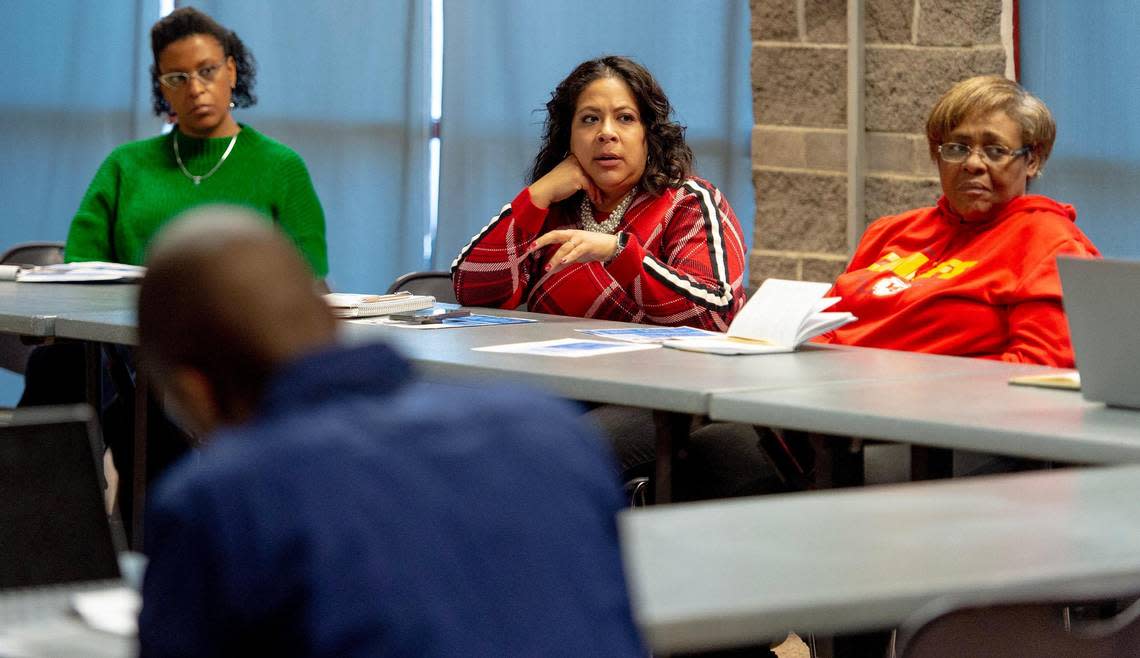
Johnson jotted down notes, and on the following Wednesday, the Partners for Peace organizations brainstormed ways they could help.
“She doesn’t squarely fall into this, but we know that violent crime has a community impact,” Johnson said. “It’s much bigger than the victim’s family, or the suspect’s family. It’s about the community grieving. And so when we can, when we encounter anybody that does not fall into one of those square categories, victim or suspect, we’re still helping them, because we have to. That’s how we’re really going to move the ball forward.”
This is why, at a meeting the week before Christmas, Johnson showed copies of a door hanger they hope to distribute in neighborhoods most affected by crime. It’s an invitation for anyone to reach out for anything, from something as small as a teenager committing petty theft who could use some guidance to something as large as a drug ring.
“Call us,” she said.
Pat Clarke, president of the Oak Park Neighborhood Association, a part of the city that sees some of the highest homicide numbers each year, has been to a few of the Partners for Peace meetings.
He remains skeptical, but optimistic. With enough work and commitment, he said, Partners for Peace has the potential to be successful.
Clarke has seen years of programs come and go with varying levels of success. Most, from his standpoint, have fallen flat.
“It’s kind of like buying something without a warranty,” Clarke said. “And that’s what we’re guilty of. Kansas City is guilty of pursuing things that don’t have no warranty.”
“I’m just saying that the jury’s still out,” he added. “I’m not saying that it won’t work, but it’s going to take all of us.”
Funding gaps
While city leaders remain confident that Partners for Peace could really make the difference, two major components are still lacking.
First, there are currently no city funds specifically earmarked for Partners for Peace. Right now, they’re drawing on money from other sources inside their partner programs, like the Jackson County Prosecutor’s Office’ Caring for Crime Survivors program, and Ad Hoc’s operating budget.
“But we know there’s going to come a time when we need to give these folks incentives to keep rocking with us,” Johnson said. “And the easiest way to do that is to give them increased funding so that they can expand their capacity.”
To get funding, there has to be proof of effectiveness, she said. And before Partners for Peace approaches Kansas City Council members with an ask of $2 to $3 million in next fiscal year’s budget, she wants to prove Partners for Peace is worth that investment.
“That’s the problem with working in this space: it’s very hard to prove what you’ve prevented,” Johnson said. “But it’s easy to prove who you’ve helped, and that’s what we’re focusing on.”
She’s hopeful, especially after the City Council in November approved $250,000 to put toward a local victim-witness relocation program. It’s a great start, but more funding is necessary for Partners for Peace to thrive, she said. The resources they’re offering, including substance abuse treatment, rental and utility and legal assistance, counseling and healthcare services aren’t cheap. And there are a lot of people in need.
The city is also in the process of hiring two social workers dedicated to violent crime, so Johnson won’t have to be the only person reaching out to families.
No citywide violence prevention plan
Partners for Peace is part of a new generation of KC NoVA, public officials said. But they don’t want to just re-enact KC NoVA, but rather take what they learned from it and create something better.
KC NoVA had a strong enforcement strategy behind it. It had an intervention strategy behind it. They offered some services to victims too. But Partners for Peace already offers much of that on a much greater scale than KC NoVA did, officials said.
But it still doesn’t include all the puzzle pieces.
The second missing piece, after funding, said Baker, the county prosecutor, is the existence of a violence reduction plan to go hand-in-hand with Partners for Peace. KC NoVA was formed as the result of a violence reduction plan. But creating that plan wasn’t possible under former Chief Smith, she said, who shared little information with her office.
Now that the next leader of KCPD has been appointed, Baker said it’s at the top of her priority list to work with the new chief to create a locally-led plan backed with academic rigor.
Before she was sworn in as Kansas City’s newest police chief on Dec. 15, Stacey Graves was at the Partners for Peace table, discussing solutions alongside the department’s social services specialists.
Graves told The Star in an interview Tuesday that a year from now she hopes to have a “robust, violent crime reduction strategy” in place created with the help of other local leaders and community members. Violent crime is multi-layered, she said, which means she doesn’t have all the answers. Graves wants to focus on core issues, like social services, poverty, access to jobs, transportation, blight, and mistrust in police.
“All of that, combined together is a horrible, perfect storm for violent crime,” she said. “ We’ve got to be results-oriented. We’ve got to figure out exactly what reduces violent crime and just keep at it.”
Asked if she thinks Partners for Peace is the answer to reducing violent crime, she said: “There’s not one thing that’s going to be the answer to violent crime. I wish it was that easy.”
But she does believe it’s making a difference as a violence interrupter.
Will 2023 see fewer homicides?
If the story of 2021 was political fights, Lucas said, the story of 2022 was collaboration.
“If you were to go back to a year ago, things were pretty frozen in Kansas City in terms of relationships, in terms of what folks were thinking was the next step. We’ve been able to transcend that,” Lucas said.
Lucas sees Partners for Peace as a collaborative effort to cut violent crime using all the resources they can, saying it’s “once and for all, us saying, ‘Alright, we recognize that it’s not just a police department budget issue.’”
He’s hopeful that Partners for Peace will begin reducing shootings, especially retaliatory shootings, “almost instantly.”
Asked if he thinks Partners for Peace could see the same success KC NoVA saw, he immediately said yes.
“Not only can, but will,” he said.
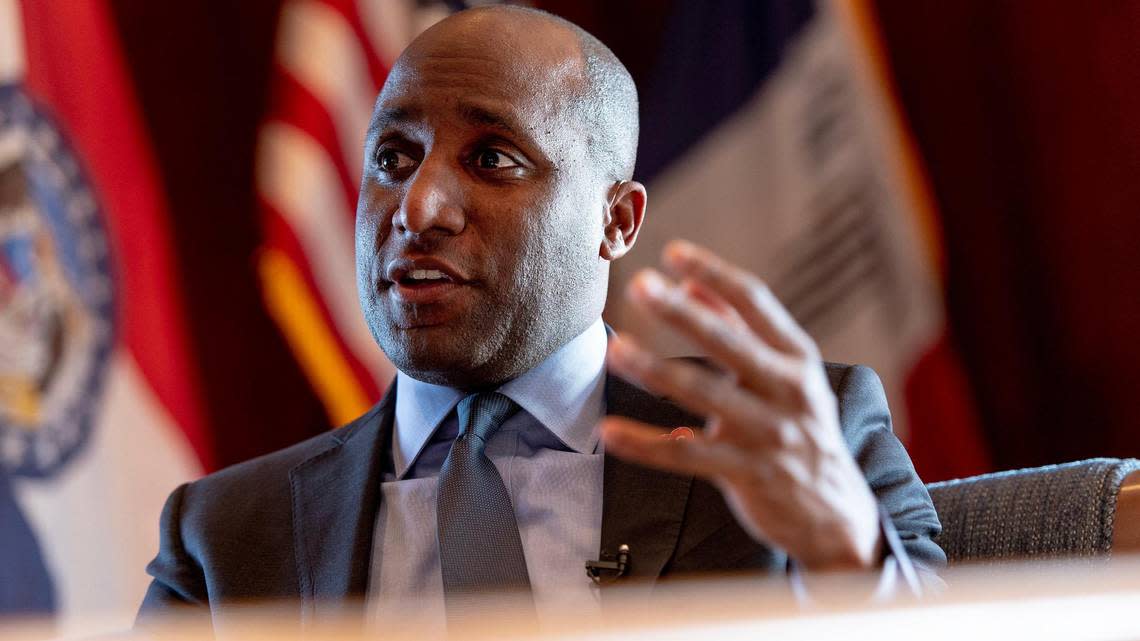
“The more contacts we have, the more work that we do, the more, frankly, that we are on somebody and saying ‘Nah, I care about you,” Lucas said. “I want to make sure that you’re not striking back.”
Does this mean that, in 2023, Kansas City will break the cycle of breaking its own homicide records every year?
“I have to think so,” the mayor said.
The prosecutor believes it will take a bit more time to see a downward trend.
“There’s no grand switch, and just like when KC NoVA was killed back in 2017, it took awhile for violence rates to really start to ramp up and settle in, so it’s going to take awhile for violence rates to come down and to level off in a real way,” Baker said.
In 2019, Lucas campaigned to get the city below 100 homicides, a promise he’s failed to accomplish since taking his seat in the mayor’s office.
“The 2019 discussion – getting us below 100 homicides – was intentional for this reason: I was born here, raised here and not just our community, but a lot of communities, we get too fixated on shaking our heads, saying there’s a challenge and then really moving on,” Lucas said in December. “And so for me it is important for somebody at some point to say: ‘Dammit. I’ll take it on.’ And that’s the role that I’ve tried to have.”
While Lucas said he still believes the city can someday get under 100 homicides, he has a new, modified promise for Kansas City heading into 2023: “There will not be a shooting … that doesn’t have multiple people on it, working on it, and addressing it.”
He promised that on every block that sees a fatal or non-fatal shooting, there will be KCPD detectives, as usual, but there will also be violence interventionists, social workers, public health and mental health outreach workers.
“That era of contention and conflict and chest-beating and no plan, that’s over. That’s over,” Lucas said. “I have great hope for what’s ahead. It’s a long slough. It won’t be quick, but now we can actually get on with the business of making our city safer.”
The Star’s Glenn E. Rice contributed.
Correction: This story has been updated to say that Partners for Peace is still in the process of relocating the mother of Shayla Curts to a larger apartment.
